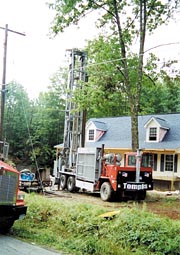
A visit with Rick Tompkins reinforces the well-deserved appreciation that knowing people have of the drilling industry and its participants. His company's story is not unfamiliar: It's been a long journey - sometimes difficult, often very rewarding and with no shortage of twists and turns. And you can tell Tompkins knows to embrace the journey because while life's destinations may well change, you're still always on the journey.

A Little Background
In 1928, David H. Tompkins was a young man of 21 years delivering milk in Bangor, Maine. One day he noticed four wooden drill rigs on a street. A man saw the curious Tompkins checking out the rigs and explained to him that the rigs were bound for Ohio and asked if Tompkins would like to join on. Tompkins said yes - but they never did make it to Ohio.On the third day of the trip, one of the rigs broke down in Newburgh, N.Y - some 60 miles north of New York City. There were no well drillers in the area at that time and when people saw the rigs, they bombarded the crew with requests to drill water wells. The rest of the trip was scrapped and shop was set up in Newburgh.
While drilling a water well at a boarding house, Tompkins met Madeline Cosman, whom he married on Christmas Eve, 1933. The couple moved to Montgomery, N.Y., the next year. In the following years, the business grew - and so did the family. A daughter, Joan, was born in 1936; son David. B. Tompkins entered the scene in 1939; and another son, Rick, came along in 1947.
In 1959, Tompkins Well Drilling moved its operations to Fort Meyers, Fla., where it had a two-year run before returning to Montgomery, its home to this day. The business was incorporated in 1964. The father and two sons worked two choppers - a 50 Keystone and a #16 Ideco. In 1965, the company purchased its first rotary drill - a brand new model from H.M. Kordick of Seymour, Conn. Describing those earlier times, Rick Tompkins says, “It was a hard business with a lot of hours of work and not much pay. Through the years, there were a lot of ups and downs.” Sound familiar?
David H. Tompkins passed away in 1989 and his two sons took over the business. In 1996, older brother David left for Missouri, where he and his son run their own drilling contracting firm.

Fast Forward
At present, younger brother Rick is running the 70-year-old business as owner and president. Long-time employee Michael Keenan is vice president. Rick's lovely bride, Aline, is secretary, making sure the office runs smoothly. Their two sons are Ricky, age 19, who presently is a driller, and Michael, age 15, who helps with pumps and installation when not at school. Other employees include Gabe Phillips and Shawn Perez who handle pumps and installation, and Thomas Boyd Jr., who is a driller. There are nine employees during peak season - and expansion is on the horizon.The company runs two new T-4 rigs - 2002 and 2003 models. “Both of our tenders - a 2002 and 2003 - are Kenwoods, custom-made for us by Amthor,” Tompkins explains. It's safe to say he qualifies as a good customer: “We've bought more than 11 bodies from Amthor.” Besides liking the products, it doesn't hurt that Amthor is located two miles down the road. Tompkins has Ingersoll-Rand do all of is drill rig maintenance because that keeps the rigs on the highest status for trade-in value. The tenders are handled in-house.
On the types of services his firm provides, Tompkins tells us, “It's mostly residential water wells and then probably about 30 percent commercial 8-inch wells for municipalities. We cover a 100-mile radius from here. We also do pumps. We have a Pulstar pump hoist rig and we have a new one on order for the New England show in March.
“A lot of the commercial work is bid, of course, but at the same time, much of it comes as a result of people wanting a local firm to handle their projects,” says Tompkins, who adds that he expects the commercial side of his business to increase considerably. “I think it's going to change to a lot more commercial work. The municipalities are looking to expand their water systems. I see nothing but things getting busier and busier around here - even if the interests rates go up - because this is one of the last frontiers that people can hit out of New York City. People who work for the city have to live within a certain distance and Orange County here is as far out as they can be. Business has increased since 9/11 because a lot of people are moving out of New York City and they're coming up this way. That's shot the land prices sky-high; this is one of the fastest-growing areas in the Northeast. The average home going up around here is anywhere between 3,500 and 5,000 square feet. Price: Right close to half a million.”
That means plans for expansion: “We're putting up a new 8,000-square-foot shop. That should be ready by this spring but it's hard to find a contractor in this area that isn't so busy it's hard to get started,” Tompkins laments.
One of the company's present buildings doubles as a candy store for vehicle buffs. The centerpiece is a 1929 Lincoln that Tompkins bought from another well driller. Apparently, the vehicle was used for events other than Sunday picnics - the bullet holes in the rear panels suggest that “getaway vehicle” would be a more accurate description of its use. His son's 1972 Chevy Nova is the latest addition. There also are two Harley-Davidson motorcycles - they come in handy, as Tompkins is a neighbor of those Orange County Chopper guys you see on television and has ridden with them on occasion. He's contemplating having them build him a custom “well driller” bike. “I talked to Paul, the owner, about it one night - about having a bike built and having it at one of the water well shows,” Tompkins relates. “And you know how well drillers are - if they saw it, they'd all have to have one. They should do mine for free so they'd get all that other business.”
In another 9/11-related matter, Tompkins Well Drilling's address is 1 Drillers Lane. “After 9/11,” Tompkins explains, “every road had to have a name on it. Ours was one of the unmarked side roads, so it had to be given a name and Aline, my wife, came up with that one.” A nice touch, indeed.

Out in the Field
On the first job we visited, the client was a builder with whom Tompkins does a lot of work. “We put in a water well for the house being built,” he recounts. “We went down 225 feet with about 120 feet of casing that had to be mudded. That was a 6-inch well with a Goulds pump; we did it in the one day. We usually install Goulds or Sta-Rite pumps - most commonly a 10-gallon-a-minute half. Those pump a lot of water from a shallow depth.
The other site we ventured to also was a new home. On this one, however, the client was the individual homeowner. He had built a home before so he acted as his own general contractor. An educated consumer, Tompkins helped him arrange for other good subcontractors in the area to use. This well went down 275 feet. On this particular job, the crew hit a big boulder early on. “You don't want that to be a problem for the plumbers, so we pulled ahead and drilled in another spot,” says Tompkins. “They've got to dig a 4-foot ditch to it and if you hit a boulder down there, you're just making problems for them, so we'll just move the hole. It was no big deal. You usually have enough room to work with.”

Looking Ahead
Asked is he has a succession plan in place, Tompkins replies, “Yes. There's Michael Keenan, who's been with me for 18 years, and my boys - and that's all set. That's something I've learned about estate planning. I've seen too many times where people have left things hanging and it turns into a big mess. You've got to sit down with a lawyer and get all these things straightened out because there's a lot at stake.”Tompkins' timetable for adding rigs and employees: “Most likely, this year,” he says. “We need it here with all the growth. And more and more, we're getting calls to do environmental projects - monitoring wells - so it's probably something we'll look into as we plan the future. A lot of times with these new developments you've got to do environmental impact studies whereby you drill several wells and pump-test them to make sure they aren't pulling down on neighboring wells. There are some big sub-divisions going up so we're doing more of that type of work. At one sub-division, we put in 15 wells - preliminary studies for 140 homes. These are expensive homes on three- and four-acre parcels. They've got to have a lot of water and probably will go with constant-pressure pumps. We were at a Franklin Electric seminar in Indiana recently and it was very interesting to think about getting into that.”
Discussing the competition in his market area, Tompkins says, “It's all good friends - outside of maybe one or two. We've got good competition; most of the guys in this area are second-generation well drillers. They're long-time well drillers and they're friends and we all get along quite well. For instance, the water conditioning - I've got two local guys in the area that I give it to and they in return send a lot of work my way. One hand washes the other.”
It's difficult to imagine Tompkins seeing it any other way. ND
Report Abusive Comment